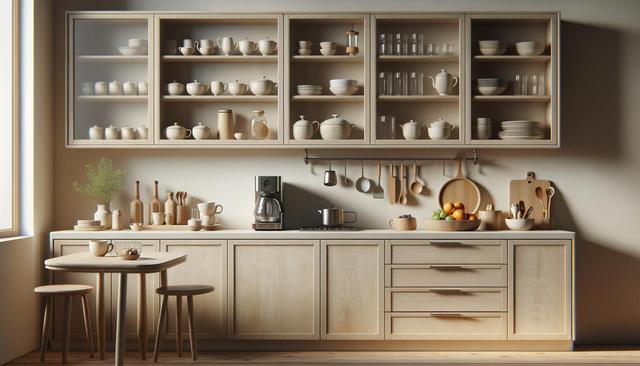Understanding the Role of Color in Kitchen Cabinet Design
Color plays a critical role in defining the atmosphere of a kitchen. When it comes to kitchen cabinets, the right color choice can significantly influence how the space feels—whether warm and inviting, cool and contemporary, or somewhere in between. Selecting a cabinet color should go beyond trends and aesthetics; it should also take into account lighting, wall colors, countertops, and flooring. Natural light can enhance lighter tones, while darker shades might provide a dramatic contrast in well-lit kitchens.
Neutral tones such as whites, grays, and beiges have long been popular choices for cabinets because they offer versatility and a sense of cleanliness. However, more homeowners are now embracing bold hues like navy, forest green, and even matte black for a striking effect. Color can also be used to highlight architectural features or create a focal point within the kitchen. When considering color, think about the long-term appeal and how it complements the rest of your home’s interior.
Trending Kitchen Cabinet Colors and Their Appeal
While some colors remain timeless, others rise in popularity due to evolving design preferences. In recent years, two-tone cabinets have become a well-regarded design choice, blending light upper cabinets with darker bases. This approach adds depth and dimension to the kitchen without overwhelming it with a single color scheme.
Some color trends worth exploring include:
- Soft sage green – offers a calming, nature-inspired look
- Charcoal gray – delivers a modern and sophisticated finish
- Warm taupe – provides a neutral yet cozy tone
- Blue-gray – merges classic and contemporary appeal
These colors are not only stylish but also provide flexibility when paired with various materials like stone countertops, brass hardware, or wooden flooring. For those hesitant to commit to a bold color, consider adding it as an accent through an island or open shelving while keeping the main cabinetry more subdued.
Material and Finish Options That Enhance Color
The material and finish of your kitchen cabinets will influence how a color looks and feels in the space. Matte, satin, and glossy finishes each reflect light differently and can alter the perception of the cabinet color. For instance, a high-gloss white may appear brighter and more modern, while a matte navy could lend a more grounded, dramatic presence.
Common cabinet materials include:
- Solid wood – offers natural grain patterns and warmth
- MDF (Medium-density fiberboard) – provides a smooth surface ideal for painted finishes
- Laminate – durable and available in a wide range of colors and patterns
- Thermofoil – easy to clean and often used for sleek, modern styles
Understanding the interplay between color and finish helps you make informed choices that support both functionality and visual appeal. Some finishes may be easier to maintain, while others may be more suitable for achieving a specific design style.
Coordinating Cabinet Colors With Kitchen Elements
Successfully integrating your cabinet color with other elements of your kitchen is key to creating a cohesive design. Cabinets are one of the largest visual components in a kitchen, so their color should harmonize with countertops, backsplashes, appliances, and flooring.
To coordinate your cabinet color effectively, consider the following tips:
- Use a color wheel to find complementary or analogous colors
- Balance warm and cool tones for a more dynamic look
- Match undertones between cabinets and countertops
- Introduce natural materials like wood or stone for texture and contrast
Additionally, consider how the kitchen connects to adjacent spaces. If you have an open floor plan, the cabinet color should flow well with living or dining area colors. This helps maintain visual continuity throughout your home.
Personalizing Your Kitchen Cabinet Color Selection
Ultimately, your kitchen should reflect your personal style and meet your practical needs. While inspiration from design trends and expert advice is valuable, the final choice should resonate with your lifestyle and preferences. Think about how you use your kitchen: do you want a bright and energizing space for morning routines, or a cozy environment for evening meals? Your answers can help guide the color decision-making process.
When selecting a cabinet color, consider:
- Your home’s overall color palette and style
- The amount of natural and artificial light in the kitchen
- Your willingness to maintain lighter or darker finishes
- Your long-term design vision
Samples and swatches can be helpful tools to visualize how colors will appear in your actual space. Be sure to test them under different lighting conditions and alongside other kitchen materials. This extra step can make a significant difference in ensuring satisfaction with your cabinet color choice.
Conclusion: Crafting a Kitchen That Reflects You
Choosing the right color for your kitchen cabinets is a meaningful part of designing a space that feels both functional and personal. With thoughtful consideration of trends, materials, lighting, and coordination with other kitchen elements, you can achieve a look that stands the test of time. Whether you’re drawn to subtle neutrals or bold hues, the perfect cabinet color is one that complements your lifestyle and enhances the heart of your home. Take your time exploring the possibilities, and enjoy the creative process of transforming your kitchen into a reflection of your unique taste.




Leave a Reply